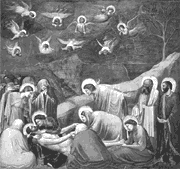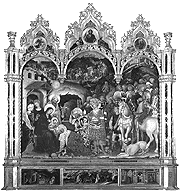ART 340 Painting
FALL 2004
Instructed by Ralph Larmann
Office: FA203 / Hours: 8-10 am MWF or by appointment
TYPES OF PAINTING |
| back to: table of contents

Lamentation
Giotto
fresco painting
c. 1305 (Pre-Renaissance)

Adoration of the Magi
Gentile Da Fabriano
tempera on wood panel (painting)
1423 (Italian Renaissance)
Painting Information
|
Types of Painting
- FRESCO
- buon fresco is the process of painting a water and pigment solution on a damp lime-plastered wall. Michelangelo's Sistine Ceiling was done in the buon fresco method. This meant that he had to begin and finish the area he was working on in one 24-hour period. After that the lime plaster has dried and will not accept pigment the same way. In Giotto's Lamentation we can see the areas that he worked in that one-day span
- fresco secco is the process of painting a water and pigment solution on a dry lime-plastered wall. The Mexican Muralists of the early 20th Century used this process. This work by Diego Rivera shows a finished fresco. The Mexican Muralists called this process mezzo fresco because they sometimes worked on both damp and dry plaster.
- ENCAUSTIC
is a paint made of beeswax and pigment. Jasper Johns, a member of the Pop Art movement of the 1960's uses encaustic in his work.
- TEMPERA
is a paint made form pigment and egg yolk. Albumen a chemical in the egg yolk provides a strong and durable vehicle for the pigment. Egg tempera dates back to the ancient Egyptian culture from which some paintings still survive. The Adoration of the Magi by Gentile da Fabriano, an Italian Renaissance painter, shows his unique use of tempera gilding. This work took stylistic characteristics from the North and from the Near East.
- OIL PAINT
is a combination of an oil (usually linseed) and pigment. Many artists prefer oils because they have a great deal of flexibility, they dry very slowly, and have a great deal of transparency.
- glazes: Transparency allows processes like glazing that depends on the transfer of light through the layers of oil. A great example of glaze painting lies in Jan Davidz. de Heem's Vase of Flowers. De Heem worked in 17th Century Netherlands where he focused on still life as his main subject. The Flemish and Dutch painters were the first to introduce oil painting (said to be invented by Jan Van Eyck) because oil was a by-product of the textile industry that flourished from the 15th Century on.
- impasto is a process of applying thick paint to a canvas. Anselm Kiefer uses heavily applied paint combined with other materials, such as straw, to create evocative and expressive works.
- ACRYLIC PAINT
is a plastic-like polymer that cleans up with water. This painting by Ralph Larmann uses acrylic glazes in the painting process.
- WATERCOLOR
in contemporary art language refers to aquarelle.
- SPRAY PAINT
has been used in one form or another since the Paleolithic period. Contemporary street and grafitti artists utilize spray paint and spray techniques.
Mixed Media
artist Robert Rauschenberg uses a plurality of materials when he makes a work of art. In the work Bed Rauschenberg uses paint on bedding materials.
|